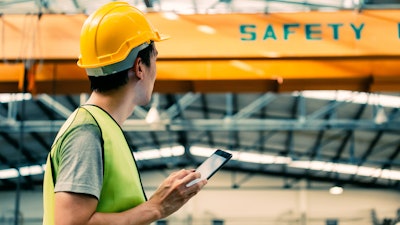
The COVID-19 pandemic has been a particularly challenging time for the manufacturing industry. Most factories have faced fluctuating resource availability and product demand, and many were forced to temporarily shut down and adjust their operational protocols to promote social distancing, proper sanitization and overall workplace safety. Automotive facilities and meatpacking plants are just two prominent examples of this.
Although this virus has placed enormous strain on manufacturers’ margins and profitability, it has also heightened the importance of workplace communication. Each day, new data and information emerge about the pandemic that could force further operational changes or, more optimistically, allow for the easing of some safety restrictions.
In this ever-changing environment, it’s paramount for factories to have systems in place that allow them to quickly and effectively communicate changes to their employees in real-time.
Emphasizing Workplace Safety and Productivity
According to a 2020 Edelman survey, workers are relying on their employers to communicate reliable, high-quality information to them during the pandemic. In fact, a majority of employees currently think their companies are more credible than the mainstream media and federal government. It’s clear that modern-day workers are hungry for engagement.
Unfortunately, most of the manufacturing industry has lagged in this realm: In a 2017 Gallup poll, just 25 percent of manufacturing employees said they were engaged at work — a number that was eight percentage points lower than the national average.
Engagement rates are low in the manufacturing industry partially because many factories continue to leverage outdated, low-tech communication tools such as bulletin boards, flyers, and phone calls to reach their frontline employees. Unfortunately, relying on these outdated communication methods can also compromise employees’ well-being: When manufacturers can’t reach workers in real time to brief them on updated safety requirements and changing processes, it places both the employees and the company at risk.
For example, I recently spoke with a manufacturing prospect that had dealt with frustrating communication issues. After learning the facility might need to close due to COVID-19, the factory’s managers needed to call all 400 of their employees one by one. Halfway through, they learned the factory would not actually need to close — and had to start the phone calls all over again.
By investing in the right technology, however, manufacturers can turn an hours-long process into one that takes just a few moments, therefore improving safety, productivity, and communication in the workplace. Beyond that, they can reach their workers in a much more effective and engaging manner, boosting employee performance over the long term and ensuring their security.
Here are three tips to help manufacturers upgrade their workplace communication strategies.
1. Go mobile. According to recent estimates, 81 percent of Americans own a smartphone. And because half of frontline employees already use their phones every day on the job, chances are good that the vast majority of your factory workers have one in their pocket while they are working and check it several times throughout the day, whether that’s during their shift (if permitted) or on breaks. These pieces of technology are designed to be engagement machines — and they provide a perfect venue for employee communication.
Workplace communication apps are on the rise across many industries, and they’re especially useful for companies with a significant number of frontline employees. These platforms help leaders make sure their announcements are both read and understood; they also foster two-way communication.
Managers can confirm when employees open their messages, and employees are encouraged to reply with questions or comments after reviewing the content. In addition, an app can serve as a digital repository for health and safety guidelines, weekly shift schedules, payroll information, and other administrative documents.
2. Employ multiple channels. Yes, take a digital-first communication approach, but don’t completely neglect your analog channels. When it comes to safety-related communication in the workplace, it’s especially important to reinforce your messaging across a multitude of platforms to make sure everyone sees, comprehends, and remembers potentially lifesaving information.
For example, if your factory needs to communicate an updated workplace safety measure to your frontline employees, you could cover every base by sending a push notification through your app, posting flyers in strategic locations, and asking middle management to verbally communicate these changes to their employees.
3. Think long term. Although the COVID-19 pandemic created an urgent need for improved communication at many manufacturing companies, this is not a time to overinvest in quick fixes. Remain focused on the big picture when assessing your options. Before purchasing a technology solution, be sure it aligns with your long-term goals and can evolve alongside your company’s ongoing communication needs.
It is certainly important to be prepared for future pandemics, weather events, or other circumstances that necessitate quick change. The right investment in the best solution will also help you effectively reach employees under normal circumstances to reach maximum productivity and engagement levels. Companies that refuse to evolve in this way will no longer stay competitive, remain slow, and put employees (if not the company itself) at risk.
Communication is key during times of crisis. It’s essential for manufacturers to ensure their frontline employees stay informed, engaged, and safe as COVID-19 continues to disrupt their day-to-day lives.
The final word
 Sztutwojner
Sztutwojner
Daniel Sztutwojner is chief customer officer and co-founder of Beekeeper, the single point of contact for your frontline workforce. Beekeeper’s mobile platform brings communications and tools into one place to improve agility, productivity, and safety. Daniel is passionate about helping businesses operate more efficiently.























